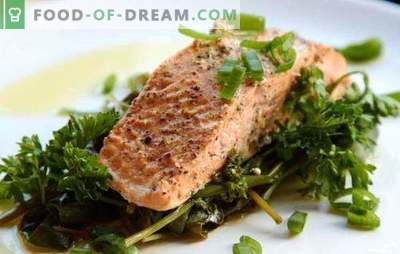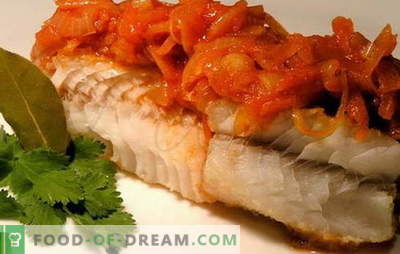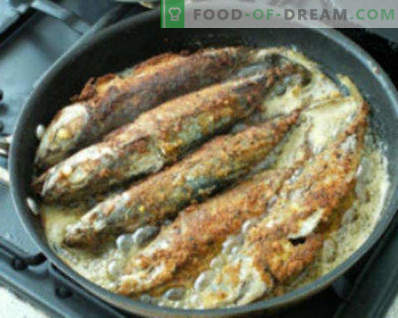
With proper preparation, a modest hake will turn into a tasty dish worthy of a festive table. This fish is no less useful than other members of the cod family, while it is inexpensive. There are quite a few recipes that make it a tasty snack, hot or cold. One of the most popular options is hake marinade. It does not require rare and expensive products, the task is feasible even for an inexperienced chef.
Cooking Features
Heck is not a fat fish and is very sensitive to how it is stored. In case of breaking the rules, frequent defrosting and repeated freezing, its structure changes, it becomes dry and tasteless. Even the most skillful cook will not be able to make him a tasty and juicy dish. Before starting to study the recipes for preparing a hake under the marinade, you should learn how to choose it correctly and prepare it for heat treatment.
- Acquire better carcasses of a hake, cooled using the method of shock freezing, rather than fillets. In this case, the risk to buy a low-quality product is much lower.
- Pay attention to the date of packaging of the product and its shelf life. The fresher the fish, the tastier the dish comes out.
- Inspect the hack package. If it has water, snow, pieces of ice, then it is better to refuse to buy. These are signs that the product has been frozen again, its structure is broken.
- A fillet of a hake may have a yellowish tint, but if it is too pronounced, and there are spots on the surface of the fish, this may indicate a product stale. Such a purchase can hardly be considered successful.
- Defrost the hake correctly. If you give him the opportunity to thaw out without a sharp temperature drop, in the refrigerator, then he will retain its structure and remain juicy.
- Most often, a fried hake is cooked under the marinade. You can fry it, divided into pieces or fillets - it all depends on how much you want to get a delicate dish. With a diet of roasting can be waived. Boil the hake carcass, cut it into fillets, cut it into pieces and continue cooking according to the chosen recipe.
- In order for the hake to become covered with a crust while roasting, it must be well breaded and fry in a sufficient amount of oil in a hot frying pan.
Heck under the marinade can be prepared according to different recipes, but the principle will be identical. If you find out several cooking options, you can experiment by creating your own culinary masterpieces.
Classic hake recipe under marinade
Composition:
- hake - 1 kg;
- wheat flour - 80 g;
- vegetable oil - 120 ml;
- water - 0, 25 l;
- carrots - 0, 3 kg;
- onions - 0, 3 kg;
- tomato paste - 10 ml;
- sugar - 20 g;
- salt, spices - to taste.
Preparation Method:
- Rinse thawed carcasses of the hake in cool water, blot with a towel. Cut into pieces about 3 cm wide. Leave the tail section slightly longer, as it is less wide.
- Sift flour, add salt and black pepper to it.
- Roll the pieces of the hake in flour.
- Heat the right amount of butter in a pan, put the pieces of fish in it.
- Fry on both sides for 2-3 minutes.
- Spread out on a towel to remove excess fat.
- Wash and peel the vegetables.
- Grind carrots on a grater with large holes.
- Cut onion into small cubes.
- Pour the remaining oil into a clean pan.
- When it warms up, dip the onion in it and fry until golden brown.
- Add the carrots, fry them with the onions for 5 minutes.
- Add tomato paste to vegetables, mix.
- Reduce heat and simmer vegetables in tomato paste for 5 minutes under the lid.
- Put the fish and vegetables in a cauldron or thick-walled pot.
- Mix water with sugar, salt and spices, pour the preparation to it.
- Place the cauldron on the stove and simmer the fish under the vegetables for 15 minutes.
Fish under the marinade is served chilled in portions. This is a self-sufficient dish that serves as a cold snack. However, if desired, it can be supplemented with mashed potatoes and pickled vegetables. In this case, the fish can be heated before serving.
Hake under the marinade in the multicooker
Composition:
- hake - 0, 6-0, 8 kg;
- wheat flour - 40-60 g;
- salt - 5 g;
- sweet pepper - 100 g;
- onions - 100 g;
- carrots - 0, 3 kg;
- vegetable oil - 40 ml;
- tomato paste - 40 ml;
- lemon - 1/4 pcs .;
- ground black pepper to taste.
Preparation Method:
- Prepare the fish by washing and drying the carcass, removing the tail and fins, cutting them into portions.
- Peel the carrot, grate it on a coarse grater or grater for Korean salads.
- Peel and slice the pepper.
- Free onion from the husk, cut into thin half-rings.
- Mix vegetables.
- Turn on the multicooker in frying mode, pouring a spoonful of oil into its bowl. If your unit does not have this mode, select the “Baking” program. Set the timer to 12 minutes.
- After a minute, flour the fish in the flour and place the multicooker in the bowl. Fry for 6 minutes under the open lid, if your device allows operation in such conditions (if not, the lid can be lowered).
- Turn the fish over, close the slow cooker and wait for the program to finish.
- Put the fish out of the multicooker on a plate.
- Wash the bowl, dry it well.
- Pour in the remaining oil. Activate the program “Frying” or “Baking” again. This time the timer should be set to 15 minutes.
- Put the vegetables, cook for 5 minutes, preferably with the lid open.
- Stir, lower the lid and cook another 3-4 minutes.
- Dilute tomato paste with water in the amount of one multi-glass (180 ml). Pour in to the vegetables. Wait for the program to finish.
- Sprinkle the fish with juice from a quarter of a lemon, hide under the vegetables, trying not to break the integrity of the pieces.
- Turn on the extinguishing program for 20 minutes.
- Carefully lay out the fish, cover with vegetables, pour the juice remaining on the bottom of the multicooker and clean it in a cool place.
Fish marinated as a cold snack. A large number of vegetables allows you to abandon the side dish.
Hake in soy-vinegar marinade
Composition:
- fillet of hake - 0, 4 kg;
- soy sauce - 40 ml;
- balsamic vinegar - 3 ml;
- boiled water - 40 ml;
- ground dried ginger - 3 g;
- ground paprika - 3 g;
- garlic - 2 cloves;
- vegetable oil - as required.
Preparation Method:
- Hake carcasses are filleted or use an already processed product. Cut the fillet into pieces.
- Pass the garlic through the press, add soy sauce, balsamic vinegar, water, seasonings. If the sauce is too salty, its ratio and water can be changed.
- Marinate the fillet of the hake for half an hour in the resulting liquid.
- Fry fish in boiling oil on both sides.
- Pour marinade and stew in it until tender.
Serving a hake is better without a marinade in which it was stewed. You can supplement the dish with Korean carrots or other vegetables prepared according to Asian recipes. Korean food lovers will love the snack.
Hake marinated with celery
Composition:
- hake - 1 kg;
- stem celery - 100 g;
- carrots - 0, 3 kg;
- onions - 100 g;
- tomatoes in own juice - 0, 5 kg;
- lemon - 1 pc .;
- salt, sugar, seasonings - to taste;
- vegetable oil, flour - as needed.
Preparation Method:
- Fish cut into pieces. Fry, breaded in flour, mixed with salt and spices, or boil for a couple, rubbed with a mixture of seasonings and salt. Heck should be made ready, as the recipe does not provide for further heat treatment of this product.
- Wash vegetables. Cut the celery into thin slices, cut the onion into small cubes, rub the carrot.
- Fry vegetables separately in vegetable oil over low heat.
- Combine the vegetables by watering them with a mixture of lemon juice, squeezed from the whole fruit, salt, sugar, juice from the tomatoes and the tomatoes themselves, peeled and broken by a blender.
- Stew vegetables 15 minutes.
- In a clean saucepan, lay the marinade in layers, fish, marinade again, and remove for 6 hours in the cold. During this time, the hake will marinate, soaked with the aroma of spices.
The dish for this recipe is fragrant and very tasty. It can decorate even a festive table.
Hake under the marinade is not as difficult to prepare as it may seem at first glance. Even an inexperienced cook will cope with the task if he strictly follows the instructions. The result will certainly meet your expectations.























